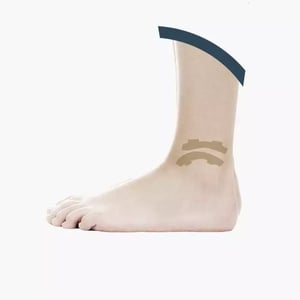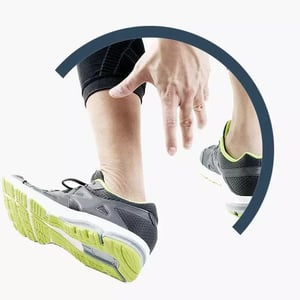Achilles Tendon
See also:
Ankle Osteoarthiritis
Ankle Sprain
“Ever since I learned to walk, I’ve loved to run.”
– Friedrich Wilhelm Nietzsche –
- The Achilles Tendon: Fragility and Strength of the Modern Human
- Anatomical Description of the Achilles Tendon
- What Is the Achilles Tendon?
- What Are the Main Functions of the Achilles Tendon?
- Why Is It So Important to Take Care of It?
- Achilles Tendon Disorders: Achilles Tendinopathy
- Insertional Achilles Tendinopathy
- Retroachillean Exostosis
- Achilles Tendon Calcification or Intratendinous Calcification
- Posterior Heel Spur (Retrocalcaneal Spur)
- Insertional Achilles Tendinopathy: Diagnosis
- Insertional Achilles Tendinopathy: Conservative Therapies
- Regenerative Medicine: PRP, Bone Marrow Aspirate, Lipogems, Monocyte-Based Cellular Therapies
- Insertional Achilles Tendinopathy: Surgical Treatment
- Non-Insertional Achilles Tendinopathy
- Achilles Tendon Rupture
- Plantar Fasciitis and Heel Spur
- Muscle Injuries: Calf Strain or Tear
- Myotendinous Injuries: Achilles Tendon Tear
- Prevention of Achilles Tendon Disorders
- Our Specialized Achilles Tendon Center and the Value of Our Research
The Achilles Tendon: Fragility and Strength of the Modern Human
The Achilles tendon is the main pillar that supports the daily movement of modern humans. It represents both a source of power and a point of vulnerability.
Running to catch a flight when you're late.
Walking briskly to reach your train carriage.
Jogging to take care of your body and mind.
Standing still, waiting for your turn.
These are all moments from everyday life where finding balance between movement, work, and well-being is a privilege.
This balance depends on our Achilles tendon—because movement is life (as Still said), and the triceps surae (commonly known as the calf) is our engine.
In this article, we’ll explore the anatomy of the Achilles tendon: what it is, what functions it performs, the main conditions that affect it, and the available treatments, surgical procedures, and therapies.
Anatomical Description of the Achilles Tendon
The Achilles tendon is anatomically the longest tendon and the one subjected to the greatest forces in our body. It therefore has a very particular structure.
First of all, it originates from the union of three muscles (hence the name triceps):
- medial gastrocnemius;
- lateral gastrocnemius
- soleus.
The first two have their proximal origin (above) the knee, at the back; the third has a distal origin (below) the knee.
This explains why shortening of the Achilles tendon can affect knee flexion. It is the reason why, when examining a patient with Achilles tendon pathology, it may be important to do so with the knee extended and flexed: this serves to separately assess the role of the muscles that insert proximally to the knee from those that insert distally.
The three muscles join to form the Achilles tendon, which inserts on the calcaneus.
The role of the Achilles tendon during gait is to plantarflex the ankle, which is why it is the main actor during the push-off phase, when the heel lifts off the ground.
In reality, it is also active in the other phases of gait, playing a role as modulator of the action of the other antagonist muscles.
The Achilles tendon also acts on the foot through the plantar fascia. The fascia, in fact, can be viewed as an entesiform expansion (a sort of widened tendon shaped like a sail) that transmits to the forefoot (metatarsal bones) the energy exerted on the calcaneus by the Achilles tendon.
The Achilles tendon is also surrounded along its path by an extremely thin tissue, called the peritenon, which envelops it and contributes to its nourishment.
Unlike what happens with other tendons, in the case of the Achilles tendon this tissue is very thin and insufficient to fully provide nourishment, which, in fact, comes largely from the muscle belly of the triceps or from the calcaneus and its insertion site.
This is why one of the common sites of Achilles tendon injury is midway between the calcaneus and the triceps, in the case of non-insertional Achilles tendinopathy.
What is the Achilles Tendon?
Its task is to transmit the force generated by the triceps surae to the entire foot and ankle complex.
Therefore, it is the tendon that must withstand the greatest mechanical stresses of the entire body.
In order to perform this function efficiently, it has an important structure for controlling both its own function and the distribution of loads (proprioception).
What are the main functions of the Achilles Tendon?
The Achilles tendon is thus a means of transmitting and controlling forces that contributes, when intact, to:
- stability
- movement
- balance
Why is it so important to take care of it?
Taking care of the Achilles tendon means paying attention to:
- the muscle tone of the triceps surae, by training it
- the myotendinous tension, through stretching and proprioceptive work
In particular, learning to listen to all the neuro-muscular spindles—those responsible for producing force as well as those responsible for control—means increasing our control abilities, learning to manage muscle fatigue, and understanding when we are approaching our limits.
It means preventing Achilles tendon injuries, but also preventing falls in general and preserving our motor abilities overall.
Achilles Tendon Conditions: Achilles Tendinopathy
The Achilles tendon can be affected by several conditions.
Some are directly related to Achilles tendinopathy, while others involve the other muscles that form part of the Achilles complex.
Here are the main Achilles tendon disorders:
- Insertional Achilles tendinopathy
- Non-insertional Achilles tendinopathy
- Muscle injuries: calf strain or tear
- Myotendinous injuries: Achilles tendon tear
- Achilles tendon rupture
- Plantar fasciitis and heel spur
Let’s analyze them in detail.
Insertional Achilles Tendinopathy
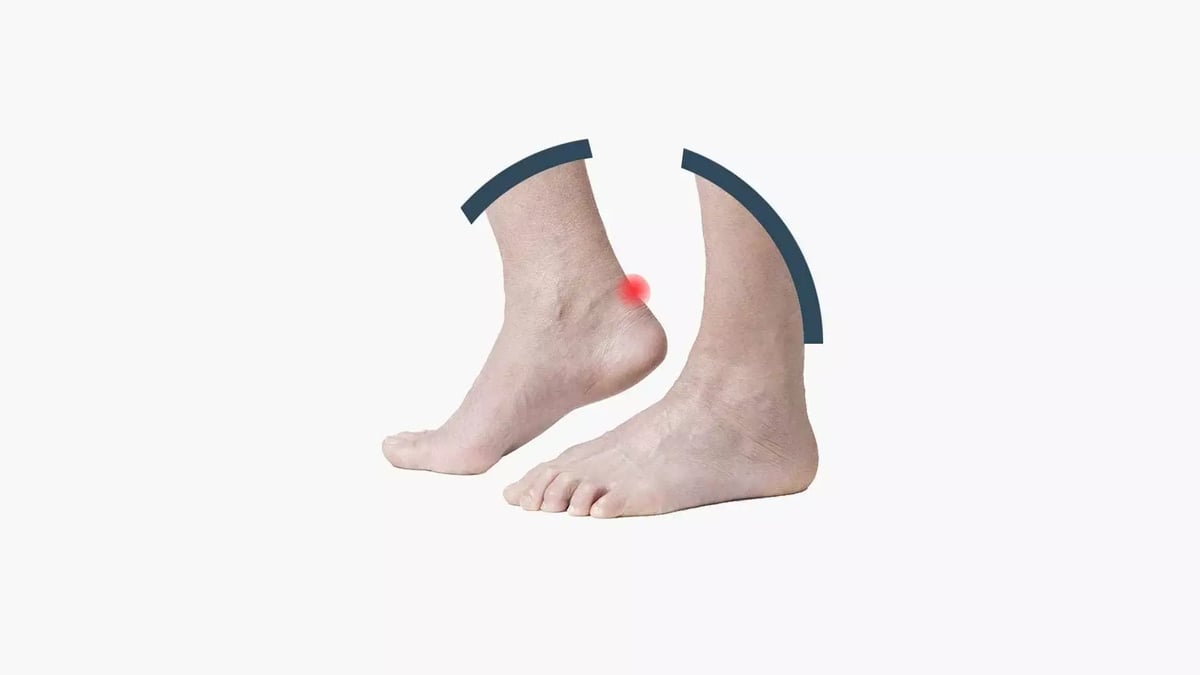
When the tendon becomes diseased at its insertion point in the Achilles region, the resulting inflammatory condition and painful symptoms are essentially caused by mechanical stress.
To simplify, we should imagine the tendon rubbing against the retroachilleal bursa (a tissue whose function is to reduce stress caused by shearing forces), which in turn rubs against the heel bone, which in turn rubs against the surrounding soft tissues, which themselves rub against the sock and the shoe.
We should picture a chain of shearing forces that produce friction and inflammation in the Achilles tendon.
This is why the athletes most affected by these issues are endurance sport athletes (middle-distance runners and marathoners), and those who use boots or footwear that increase posterior friction during their activity (such as skiers and football players).
In everyday life, the frequent and continuous use of heavy safety shoes can also contribute to the development of this condition.
Of course, there are various features that help define different subcategories of this pathology:
- Retroachilleal exostosis
- Intratendinous calcifications
- Retroachilleal heel spur
Retroachilleal Exostosis
In classic retroachilleal exostosis, the key factor is an excessive prominence of the heel bone. The patient complains of posterior heel pain, and upon initial examination, a sort of posterior "bump" is clearly visible. This bump negatively contributes by increasing volume and, consequently, friction.
Insertional Achilles Tendinopathy with Intratendinous Calcifications
These are alterations of the tendon tissue (metaplasias) that lead to real structural changes in the tendon, comparable to the presence of “little stones” inside it.
These calcifications affect the alignment of the tendon fibers, thereby interfering with the proper function of the Achilles tendon. They cause inflammation and pain, which can be resolved by surgical excision.
It’s important to distinguish these from the calcifications often seen in patients who have undergone Achilles tendon lengthening.
In such cases, the calcifications are not a sign of disease, but simply a healing response by the tendon following the lengthening process.
Retroachilleal Heel Spur
This is a highly disabling condition, and patients are often quite worried by the intensity of the pain.
The first therapeutic step taken by the specialist is to reassure the patient: these individuals are not at increased risk of Achilles tendon rupture.
Therefore, while it can be a debilitating condition, it does not increase the risk of tendon rupture.
It is often associated with intratendinous calcifications and, not infrequently, with retroachilleal exostosis.
In these cases, it is essential to identify the pathology or pathologies responsible for the pain and propose selective, tailored treatments for each individual patient.
Insertional Achilles Tendinopathy: Diagnosis
Diagnosis is clinical. In this case, skeletal imaging completes the diagnostic process.
Often, a weight-bearing X-ray of the foot (particularly the lateral view) is sufficient.
In uncertain cases, it is preferable to use a second-generation imaging test, such as a Weight-Bearing CT scan, which provides a three-dimensional view of the heel bone and the Achilles tendon insertion under load. This offers a more comprehensive image while also correlating with functional weight-bearing conditions.
Insertional Achilles Tendinopathy: Conservative Treatments
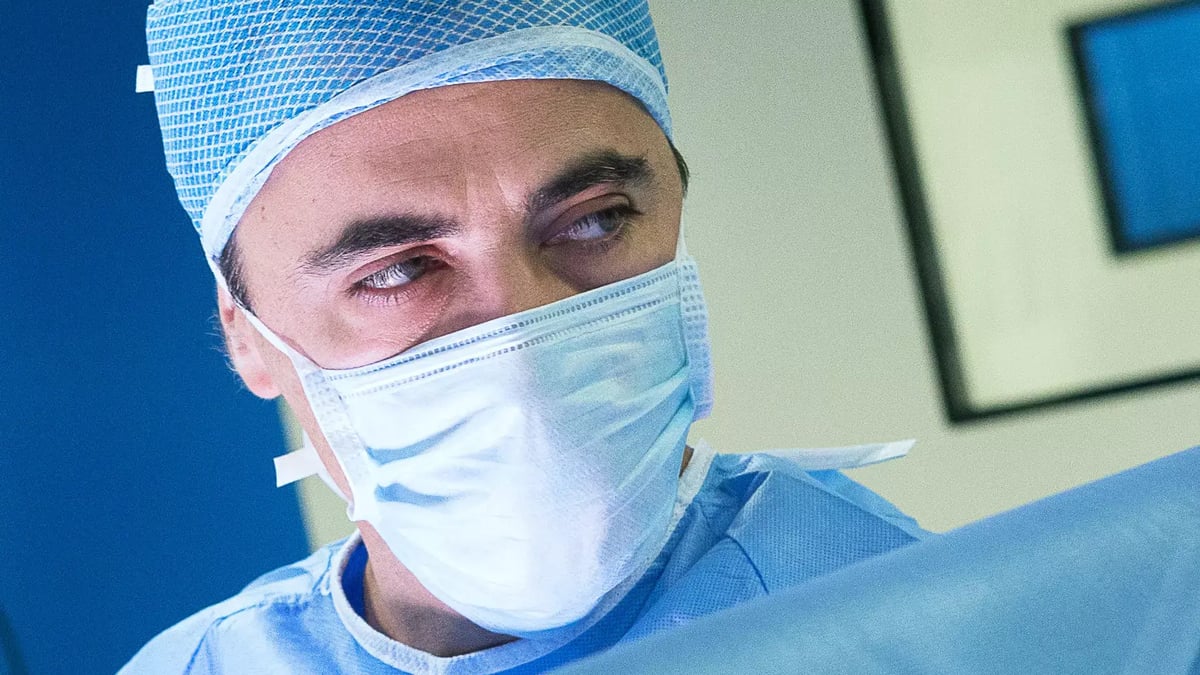
This is the first strategy to pursue. Physical therapies play a key role.
The goal is to reduce local inflammation, as inflamed tissues typically have greater volume and are hypersensitive to pain.
The purpose of the therapies is to increase microcirculation, promote the removal of inflammatory byproducts, and by reducing inflammation, decrease the volume of tissues affected by the condition.
The most commonly used therapies are:
- Focused shockwave therapy
- Tecar therapy and laser therapy
Though their mechanisms of action differ, their objective is the same: to reduce inflammation and stimulate microcirculation.
Physical therapies should be accompanied by manual therapies and physical activity that helps improve tendon elasticity. The ideal exercises are eccentric loading exercises for the Achilles tendon (basically, stretching against resistance).
Personally, I never prescribe silicone heel lifts, which might have the benefit of slightly reducing mechanical stress on the tendon by inducing a mild equinus position, but undoubtedly have the negative effect of reducing the internal shoe volume and increasing the stress caused by shearing forces.
.
Regenerative Medicine (PRP, bone marrow aspirate, Lipogems, cell therapies with monocytes)
Unlike other conditions, in these cases the main factor contributing to the patient’s symptoms is inflammation caused by friction, not degeneration.
I rarely recommend regenerative medicine for this group of conditions. The goal, in any case, is solely anti-inflammatory.
For this reason, PRP (Platelet-Rich Plasma) may be a useful and cost-effective option among regenerative medicine treatments.
Of course, in these cases, it’s important to explain that PRP injections can be painful, since they are administered in an inflamed area with limited space to inject and accommodate the fluid.
Undoubtedly, for this group of disorders, regenerative medicine is not a miracle cure and should only be considered in selected cases.
Insertional Achilles Tendinopathy: Surgery
When conservative treatments fail to achieve the desired results, surgery becomes a reliable option.
There are endoscopic solutions involving two small incisions ("tiny holes") on the medial and lateral sides of the tendon.
These are used to insert an endoscope (camera) and a burr to remove excess bone tissue. This is a minimally invasive and highly effective solution that became very popular in the early 2000s. However, it was later associated with numerous recurrences, due to the inability to clean inside the tendon (no intratendinous debridement possible).
In simple terms, you cannot operate inside the tendon using this method.
Today, this technique is only used in selected cases, where no intratendinous calcifications are present.
When the anatomical alteration is more complex, the Zadek osteotomy is indicated. This can also be performed using a minimally invasive technique.
The goal of the Zadek osteotomy is to modify the Achilles tendon’s lever arm on the heel bone (calcaneus).
In any case, these are minimally invasive procedures that do not require major incisions—just two small holes—and allow for immediate weight-bearing after surgery, with full recovery within a few weeks (6–8 weeks), and driving resumed after around 4 weeks.
When intratendinous calcification is present, the technique used by my team involves a midline intratendinous incision.
Through this approach, the calcification—located just behind the tendon—is exposed.
The problematic portion of the calcaneus is then easily removed without the need to detach the tendon from the bone.
This is a modern and innovative concept: in this way, the Achilles tendon maintains its original tension, which would otherwise be lost in procedures involving detachment and reinsertion.
This type of surgery can be done as a day-hospital procedure or with one overnight stay.
The post-operative course includes using two crutches for 3 weeks, with full weight-bearing allowed from day one.
Driving can typically be resumed around day 40 post-op.
Return to competitive sports can generally be expected within 4–6 months after the operation.
Non-Insertional Achilles Tendinopathy
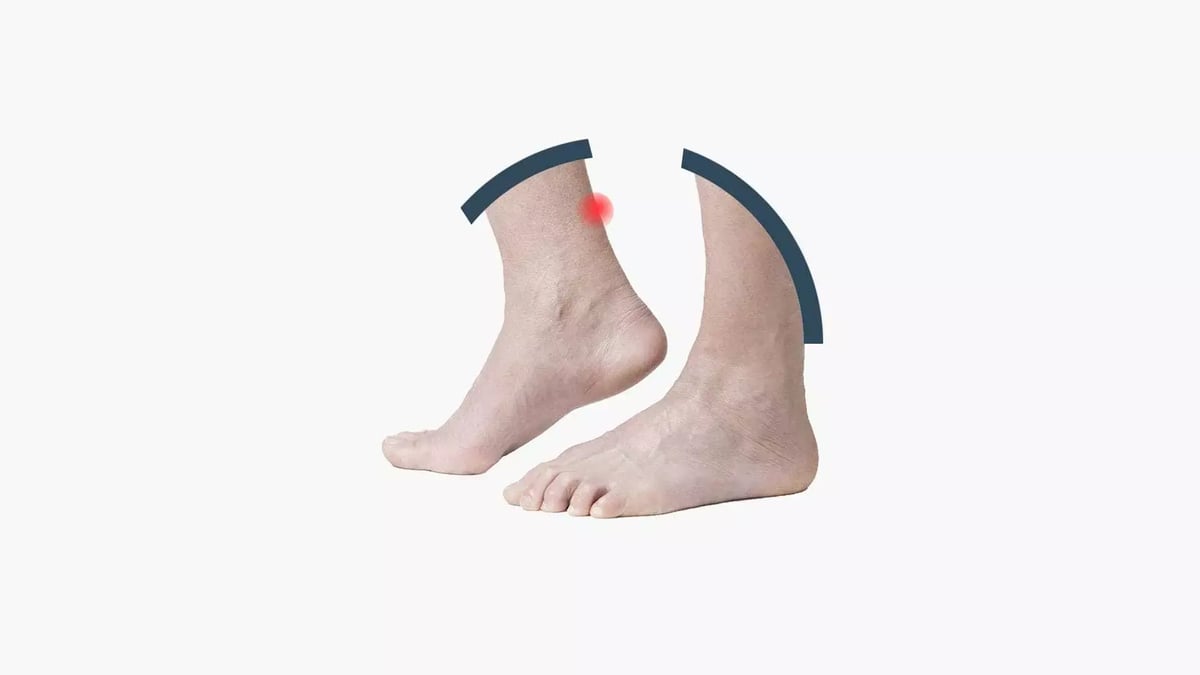
The tendon can become diseased approximately two to three centimeters above its insertion on the calcaneus, leading to a characteristic hourglass-shaped deformity of the tendon.
Non-insertional Achilles tendinopathy, also known as Achilles tendonitis or tendinosis, is a condition that can have a subtle onset. The pain is not constant, at least in the early stages.
However, this condition carries a risk of Achilles tendon rupture. This risk has been linked to poor vascular supply to the tendon.
In fact, the condition typically occurs midway between the tendon’s insertion on the calcaneus and the muscle-tendon junction—that is, in the anatomical region farthest from the tendon’s vascular and nutritional support.
It most commonly affects patients aged 30 to 50, though it’s not uncommon even in people in their thirties. Early diagnosis is key to managing and minimizing the risk of a complete tendon rupture.
Diagnosis of Non-Insertional Achilles Tendinopathy
However, a standard MRI is not very useful for long-term monitoring of the condition or understanding how it evolves over time.
In the future, functional imaging techniques, such as elastography (a method that studies the tendon’s ability to vibrate under stress) or T2 mapping MRI, may be used to track the progression of the condition and to assess the outcomes of conservative, regenerative, or surgical treatments.
Non-Insertional Achilles Tendinopathy: Conservative Treatments
Conservative therapy is undoubtedly the first line of treatment.
Focused shockwave therapy, Tecar therapy, and magnetotherapy aim to stimulate vascularization in the affected area.
A complete resolution of symptoms is possible with these methods, but even in such cases, it is important to monitor the patient over time to assess and, when possible, prevent the risk of tendon rupture—at which point regenerative medicine becomes the next step in the therapeutic pathway.
Regenerative Medicine (PRP, Bone Marrow Aspirate, Lipogems, Monocyte-Based Cell Therapies)
Regenerative medicine aims both to alleviate symptoms and to reduce the risk of tendon rupture by providing a regenerative stimulus.
For this pathology, it is essential to prioritize regenerative effects over purely anti-inflammatory ones.
Our team was among the first to study the use of the stromal vascular fraction of adipose tissue as a source of multipotent cells. In short, we were the first to treat non-insertional Achilles tendinopathy with multipotent cells derived from adipose tissue, comparing the results to PRP.
We demonstrated both the safety and efficacy of this treatment and published our findings in Europe’s leading journal for sports orthopedic surgery.
It’s important to note that regenerative medicine does not restore the original anatomical shape of the Achilles tendon. The tendon will often retain its hourglass appearance, but may become asymptomatic, and in successful cases, the area of degenerated tissue is reduced.
Further Details
The most accessible form of regenerative therapy is PRP (Platelet-Rich Plasma), a cell-free therapy with primarily anti-inflammatory and partially regenerative effects.
However, cell-based therapies represent the most advanced and scientifically robust solutions.
PRP (platelet gel or platelet paste) is derived from the patient’s own blood, collected via simple venipuncture in an outpatient setting. Through biochemical and centrifugation processes, the cellular components are separated from the acellular plasma, allowing for the isolation of inflammation mediators.
It’s important to understand that PRP refers to a method, but there are various types of PRP, each with different characteristics, goals, and potentials. Choosing the best biotechnological option for each patient—and informing the patient—is crucial.
That said, non-insertional Achilles tendinopathy is primarily a degenerative condition, and regenerative medicine plays a central role, especially in what is now known as the “immunocentric revolution.”
Simply put, this term refers to the ability to use mononuclear cells, which can be isolated from blood, fat, or bone marrow, to suppress inflammation and degeneration, while also attracting regenerative cells (also harvested from fat and bone marrow).
This approach essentially summarizes the concept of cell-based therapy for non-insertional Achilles tendinopathy.
Our research group has made significant contributions in this area, beginning with the first randomized controlled trial comparing cell-free and cell-based regenerative therapies (mesenchymal cells from adipose tissue) for the treatment of non-insertional Achilles tendinopathy
“Intratendinous adipose-derived stromal fraction (SVF) injection provides a safe, efficacious treatment for Achilles tendinopathy: results for a randomized controlled clinical trial at a 6-month follow-up” (Usuelli FG, et al. Knee Surg Sports Traumatol Arthrosc. 2018. PMID: 28251260 Clinical Trial).
This remains one of the most cited studies on the subject in the international literature.
Later, our therapeutic algorithm was proposed as a guideline in the international scientific journal Foot and Ankle Clinics:
“Biologics in the Treatment of Achilles Tendon Pathologies” (Indino C, D’Ambrosi R, Usuelli FG. Foot Ankle Clin. 2019 Sep;24(3):471–493)
Non-Insertional Achilles Tendinopathy: Surgical Treatment
.webp?width=1200&height=675&name=f-usu-operatoria-desktop-min.jpg%20(1).webp)
When conservative treatments and regenerative medicine fail to provide the desired results, surgery becomes necessary to achieve a dual goal:
alleviate the patient’s symptoms, effectively resolving them, and
prevent a potential Achilles tendon rupture.
There are two main categories of surgical procedures for non-insertional Achilles tendinopathy:
- Surgery on the Achilles-plantar complex, often combined with regenerative medicine, depending on the goal:
- to stimulate the biological healing process of the diseased tendon
- to reduce biomechanical stress on the affected tendon
- Tendon transfer surgeries
Techniques to Stimulate the Biological Healing Process
Historically, the best known procedure is tendon scarification, which involves open cleaning of the tendon combined with small cuts to induce regeneration.
The real risk of this solution is that it damages the tendon more than the body is able to regenerate. For this reason, the natural evolution of this technique is Achilles stripping, a minimally invasive solution that, through four small 'small holes', aims to promote the detachment of the peritenonium (the sheath surrounding the Achilles tendon, which is richly innervated and vascularised) from the tendon, inducing deafferentation of the nerve fibres that transmit pain and inducing bleeding and, therefore, regeneration.
Based on the body's autologous regenerative capacity, stripping can be implemented with regenerative medicine techniques (an immunocentric revolution using mononuclear and mesenchymal cells taken from adipose tissue or bone marrow aspirate) to maximise the subject's regenerative potential.
Techniques for Reducing Biomechanical Stress on the Affected Tendon
There are several minimally invasive technical solutions: sectioning of the tricipital fascia according to Strayer, Bauman or Barouk.These techniques involve small incisions (less than 2 cm) in different locations, but with the common goal of releasing the Achilles-plantar complex.
These solutions can be combined with Achilles stripping and regenerative medicine.
TENDON TRANSFER SURGERY:
There are two different options:
- transposition of the flexor hallucis longus;
- use of the semitendinosus.
The semitendinosus tendon is taken from the ipsilateral knee, as is customary in anterior cruciate ligament surgery, without compromising knee function.
When using this technique, three small incisions are made, two proximal to the pathological area and one at the level of the calcaneus. With this type of tendon transposition, the semitendinosus is used to bridge the lesion in order to mechanically unload it. This controls the symptoms and reduces the risk of rupture.
It is an excellent, minimally invasive technique, with the limitation, however, of providing mechanical rather than biological support to the diseased tendon.
For this reason, transposition of the flexor tendon of the big toe is now much more widely used to supplement the Achilles tendon.
This is a surgical technique that can be performed endoscopically or through a small incision behind the tibial malleolus.
The flexor tendon of the big toe is isolated and transferred to the calcaneus. This technique provides biomechanical and biological (vascular) support for the tendon, controlling symptoms and reducing the risk of injury.
This procedure can be performed on an outpatient basis or with an overnight stay in hospital. Immobilisation with a brace is required for about 3 weeks, but weight-bearing is allowed immediately.
A return to normal daily activities with full weight-bearing is expected within 2 months, and a return to competitive sports approximately 4-6 months after surgery.
For further information, in this article we have discussed the main differences between insertional and non-insertional tendinopathy.
ACHILLES TENDON RUPTURE
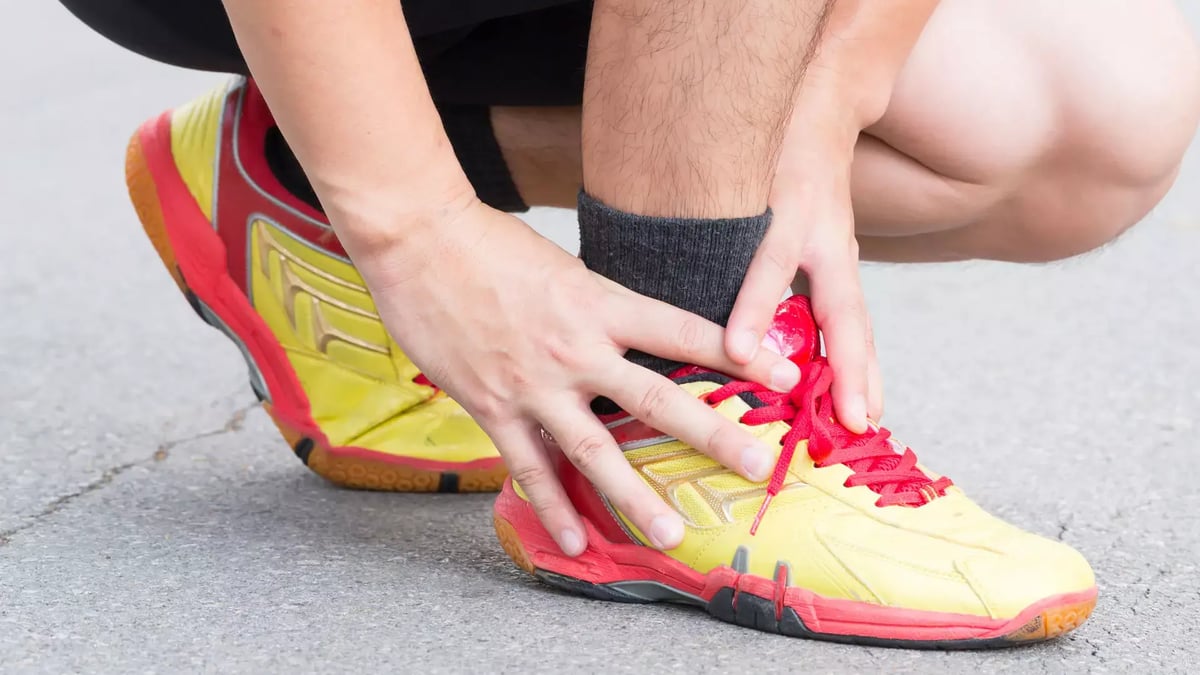
With the exception of rare cuts, Achilles tendon rupture is always the final expression of a chronic degenerative process.
Patients often describe precisely the moment when the injury occurred.
However, in these cases, it is best to imagine the Achilles tendon as a frayed rope in which the final mechanism of injury plays a very minor role.
The rupture is an expression of the degenerative disease.
It generally affects patients between the ages of 40 and 60, but it is not uncommon in athletes in their thirties.
Patients typically describe a sharp pain, associated with the sensation of being “kicked from behind”.
In these cases, a completely conservative treatment that does not require surgery can be envisaged. However, this involves a series of casts (above the knee) and a period of immobilisation lasting approximately 90 days.
This is why, in patients with an active lifestyle, surgery is the fastest and most efficient way to recover after a complete Achilles tendon rupture.
The injury can be diagnosed clinically alone. Ultrasound is the first-line imaging test to confirm the clinical diagnosis.
The role of MRI (magnetic resonance imaging) is to establish the extent of retraction of the lesion stumps in order to identify the best technique.
In cases of minimal diastasis between the two lesion stumps, there are now minimally invasive surgical solutions that, even without incision or with a minimal incision (2-3 cm), allow realignment of the lesion stumps and excellent, rapid restoration “ad integrum”, minimising invasiveness.
For a more complete description of these treatment options, please refer to the specific article on Achilles tendon rupture.
In cases where the rupture has caused a diastasis of the stumps (more common in cases of chronic Achilles injuries, i.e. diagnosed late, more than 20 days after the event)
or in cases where the rupture occurs at the level of the myotendinous junction (i.e., a high injury), the surgical solution of choice for my team is tendon transposition of the flexor hallucis longus.
This avoids major injuries and uses a healthy tendon (the flexor hallucis longus that is transposed) as a tool for healing the injury.
This choice minimises the invasiveness of the operation and promotes a quick return to sporting activity.
However, it should be remembered that, regardless of the surgical choice, the recovery process requires immobilisation for approximately 40 days.
Our protocol differs from the traditional one, as it involves immediate immobilisation at 90° to promote early rehabilitation.
Full weight-bearing is allowed after approximately 2 months, and driving after a period ranging from 2 to 3 months.
Competitive sports are allowed after a period ranging from 6 to 9 months.
Obviously, in these cases, regenerative medicine plays a synergistic role in stimulating the regenerative processes initiated by surgery.
PLANTAR FASCITIS and CALCANEAL SPINE
Plantar fasciitis is an inflammation of the plantar fascia, which most often manifests itself as a burning pain, incapacitating the heel, often accompanied by an X-ray image of a “spur”.
For a long time, the X-ray image of the spur was interpreted as the cause of the problem, and treatment was focused on this image.
Today, it is clear that the symptoms reported by patients are caused by excessive stress on the plantar fascia, which becomes painful at its insertion point on the heel and along its course in the foot.
However, the fascia is a structure that is closely connected in its function to the triceps and the Achilles tendon.
This is why I feel it is necessary to discuss it in the section dedicated to the Achilles tendon. Its role, in fact, is to transmit the energy produced by the contraction of the triceps to the forefoot, through the Achilles tendon and the calcaneus, which acts as a sort of mechanical pulley.
Fasciitis is a condition that often occurs in the “mid-seasons”, in spring or at the end of summer. The symptoms start when you change your footwear. In spring, for example, you start wearing flat shoes, or in autumn, you stop wearing them.
It is a problem that manifests itself as sharp pain, which can often become chronic. Initial treatment is obviously conservative.
Stretching the triceps and flexors (the “calf”) plays a key role.
In addition to this activity, physical therapies that stimulate local microcirculation, such as focal shock waves and Tecar therapy, play a synergistic but not substitute role. Conservative therapy is the solution in over 80% of patients who are consistent and motivated to repeat the exercises.
Only in cases where conservative therapies fail is regenerative medicine a useful strategy to consider.
The last resort is surgery, which should be considered with moderation and caution.
Today, there are completely minimally invasive and safe solutions, but given the great potential of conservative treatment, it is only really indicated in extremely selected cases.
Obviously, the correction of a concomitant skeletal deformity, such as a supinated hollow foot or a pronated foot, can contribute to the final result, carefully weighing and commensurating the extent of the pathology and the importance of the intervention.
Muscle injuries: calf tear or strain
WHERE?
Muscle injuries can affect the deep layer (soleus muscle) or superficial layer (medial and lateral gastrocnemius muscles) and can be incomplete (strains) or complete (muscle tears). The patient reports pain in the calf area, which in the case of major tears may be a burning pain, comparable to an “amplified” cramp, and may be followed by the appearance of a bruise (haematoma).
Diagnosis
The diagnosis is clinical, but ultrasound and MRI scans are obviously important to complete the diagnosis, study the type of injury and monitor the healing process over time.
Cure
Treatment is conservative. In the early stages, therapeutic attention is focused on reducing the haematoma and preventing the injury from “worsening”. Physical therapies may be useful (laser therapy and Tecar therapy), but it is important to avoid hyperthermia, which can induce calcification at the site of repair.
The use of regenerative medicine is not recommended in most of these cases, at least in the acute phase.
During the rehabilitation phase, it is important to strengthen the muscles eccentrically in order to restore muscle strength and elasticity and protect the repair area.
Myotendinous injuries: Achilles tendon rupture
What are they?
Mytotendinous injuries are injuries in which the patient feels a sharp tear in the middle of the leg, comparable to the sensation of being kicked from behind.
The disability is significant and comparable to an Achilles tendon rupture, with a larger haematoma.
Diagnosis
The diagnosis is clinical. Thompson's test (squeezing the calf while the patient is lying prone and observing the presence of corresponding plantar flexion of the foot) and Vallum's sign (alteration of the normal anatomical profile with the presence of a local depression) are unequivocal. However, it can be difficult for the specialist to distinguish between a tendon rupture and a rupture at the myotendinous junction. This has an impact on the subsequent treatment.
That is why I believe that magnetic resonance imaging plays an important role in such cases: it allows the lesion to be located precisely!
Cure
In this case, the question to ask is: ‘Is it possible to heal conservatively, without surgery?’ The answer is yes.
Healing is a ‘restitutio ad integrum’; in other words, without surgery, will you return to how you were before? The answer is no.
Finally, conservative treatment requires long periods of immobilisation, often exceeding 90 days.
This is why treatment for this injury can be conservative, but in an active patient (not only in a patient with high functional demands or a top athlete), surgery is recommended.
This is especially true since tendon transpositions offer reliable, minimally invasive and fast treatment options.
In the past, these procedures were performed with large incisions and consequent significant surgical scars with the aim of repairing the injury, literally turning over a portion of the myotendinous fascia to regenerate the tendon and the broken myotendinous junction. These are moderately invasive procedures, with poor results in terms of functional recovery.
Today, this type of injury are treated with surgery that requires an incision of about 1.5 cm or endoscopy, taking a healthy tendon (flexor longus hallucis) from this incision, near the tibial malleolus, posterior to it, and using it as a new Achilles tendon and as functional and healing support for the injured Achilles tendon complex.
In short, instead of repairing degenerated tissue by simply putting a “patch” on it, the diseased functional unit is replaced with a healthy and well-vascularised tendon: the flexor longus hallucis.
In experienced hands, this procedure takes about 20 minutes and allows immediate weight-bearing, protected by a brace for 3 weeks, a return to driving and normal functions without braces after about 4-5 weeks, and a return to sports after about 3 months.
Prevention of Achilles tendon disorders
We are not talking about physical activity as a cliché or something we all know is important but which our daily routine has the ability to distract us from.
The Achilles tendon heals and ages with us.
The well-being of our body also coincides with the well-being of our tendons.
Our well-being is a cocktail of biochemical stimuli that our body modulates from both outside and inside. It is a cyclical and orderly rhythm, regulated by the sleep-wake cycle, which primarily governs our hormonal balance, along with other stimuli.
Physical activity is related to fatigue and our production of cortisol and other hormones.
This is why physical activity is important for our Achilles tendon and, first and foremost, the right physical activity is regular physical activity.
Setting achievable goals that are compatible with our daily routine and our level of well-being is essential, as is setting possible targets to achieve through improvement.
Therefore, the ideal physical activity for our tendons is one that we can plan regularly and that helps reduce our stress levels.
We are in line with modern bio-hacking theories, which many coaches and motivation and communication experts refer to.
Whatever activity you choose, it will be important to then focus on something specific for your Achilles tendon.
It is not true, for example, that running puts excessive strain on our tendons. However, if we are dedicated to running, it is useful to remember that our tendons need attention.
Regularly planning triceps (calf) stretches is essential to restore the correct elasticity of the tendon itself at the end of the chosen physical activity.
Stretching, however, also deserves consideration.
In fact, our muscles do not behave as isolated functional units.
Leibniz said: “a monad has no doors or windows”.
Well, our muscles are not monads, but are intimately related to the muscle groups with which they work (agonists and antagonists). Stretching and, if necessary, eccentric stimulation involving all the postural chains is therefore really effective.
In the case of the Achilles tendon, for example, it is important to also focus on the posterior muscles of the thigh (biceps femoris, but not only) and on the mobility of the pelvis. Finally, it is useful to also involve the antagonists, focusing on the tibialis anterior and extensors.
Nutrition, like physical exercise, contributes to well-being, but for years, the importance of various supplements or specific diets for the musculoskeletal system has been uncritically emphasised.
However, research has highlighted the presence of markers of well-being that predispose individuals to healing or reduce the incidence of systemic or local inflammatory diseases.
Among these, vitamin D and the presence of polyunsaturated fats are indicators.
Our centre specialising in Achilles tendons and the value of our research

My team, supported by the Scientific Directorate of IRCCS Galeazzi, where I worked for 10 years before becoming Head of Ankle and Foot Orthopaedics at Humanitas San Pio X, designed and conducted the first study described in Orthopaedics on the use of cells taken from adipose tissue as a regenerative stimulus for non-insertional Achilles tendon pathology.
In this study, we compared PRP with the stromal fraction of adipose tissue for the first time.
Our study was the first to describe this treatment as safe and effective.
This study formed the basis for further scientific research and the identification of better imaging methods for the Achilles tendon. To date, magnetic resonance imaging, with dedicated mapping, is an ideal tool for monitoring the evolution of non-insertional Achilles tendinopathy over time.
The results of these studies have been published in some of the most prestigious journals in the field (KSSTA, British Bulletin and Foot and Ankle Clinics).
This is an area of research to which my team remains passionately committed, convinced that regeneration is the key to reducing the invasiveness of surgical procedures and achieving ever greater patient satisfaction.
